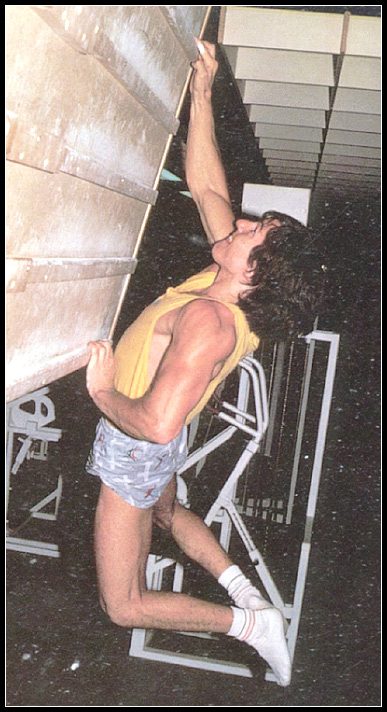A Beginner’s Guide to Campus Board Training
There are many schools of thought when it comes to campusing, but that which avoids injury utilizes the largest rungs

Climbing without feet is one of the most exciting movements to watch. The term “campus” originated in a German university gym called The Campus Centre. The facility housed the world’s first campus board, which was built by German crusher Wolfgang Güllich in 1988. He built the board as a training tool for his then-futuristic project in the Frankenjura. This route, defined by its mono sequence, would become the world’s first 9a/5.14d called Action Directe.
Though few of us will ever attempt routes that have cruxy mono sequences, campusing remains a useful tool. There are times when cutting feet is the best and easiest way to finish a climb. The concept is only furthered by the advent of competition climbing, where campusing is sometimes the only beta for a sequence. Though it seems common enough, utilizing a campus board to its fullest potential is not a simple task. There are many exercises one can accomplish on a board and each provides a very different sort of conditioning. So how do you get into it?
The First Steps
Before we let ourselves loose on the board, the first thing that is worth noting is our current ability. This can be judged by simply trying to campus a boulder in the gym. This problem can be built with jugs, in-cut pinches, or positive sloper-balls. Try picking a boulder problem that offers simple movement on the most positive holds. The first goal should be to complete the problem without using any feet. If this is impossible, it might be worth spending time conditioning with pull-ups instead of campusing. For the climber that cannot do pull-ups, work to complete negatives, pull-ups that originate from a fully locked off position and conclude in extended arms. While campusing, it is important to ensure that shoulders are engaged at all times.

Alternating Holds
After a couple of weeks, the aforementioned boulder problem will be sent entirely without the use of feet. At this point, you might want to try campusing other boulder problems in the gym. This is good practice, though it might be more beneficial to spend time on the same boulder problem in an effort to refine its movement. “Refining movement,” in this case, means campusing the boulder problem smoothly. Instead of hucking for glory between every third hold, try locking off and moving between the holds with limited swing.
This exercise should conclude in the climber campusing the route without matching, alternating between left and right hand movements as they climb. If you wish to push this exercise even further, try completing a one-arm lock off on each hold between moves. This will simulate the way you will ultimately end up campusing in more advanced exercises.
The Campus Board
After these preliminary exercises have been completed, you are ready to campus on the board. There are many schools of thought when it comes to campusing, but that which avoids injury utilizes the largest rungs. If you have jug rungs, excellent. If you are limited to large wooden rungs or plastic sloper rungs, these should do well so long as they do not tweak your fingers. It can be tempting to wish to train finger-strength alongside the power-training inherent to the campus board. Do not fall into this trap.
Hangboards exist for training smaller holds. The campus board exists to improve the power related aspects of climbing as well as contact-strength. Contact-strength is already exceptionally challenging on the fingers and, as such, small campus rungs are not necessary until the large rungs have become too easy.
Form on the campus board should be something similar to the form of a perfect pull up. Ideally, your form will not exhibit any swing or momentum from the hips. Campusing with your hips is easier than maintaining square hips, but the goal is to become stronger at climbing, not to find the easiest way up the board. Strive to move between rungs seamlessly, alternating as you go. If you are within your first year of climbing, it is unlikely that you will need to campus more than one day a week. The less impact on your fingers the better.
The Dangers of Campusing
Like all exercises in climbing, there are many dangers to campusing that the new climber should consider. Firstly, the campus board puts an excess of strain on your elbow at the bicep’s insertion. This is easily mitigated by antagonist muscle training such as push-ups or other triceps related exercises.
Secondly, the board can put a lot of strain on your fingers and wrists, especially if you are simply pulling up and hoping that your fingers catch a rung. Campusing is an exercise concerned with two concepts in climbing. Power and Control. Power training, or the distance with which someone can pull and still grab a hold, should be separated by large rests between repetitions and the frequency of the pull should be relatively low.
By comparison, the smoothness with which a person moves is defined by their level of control. It is joint stability and is more useful to the new climber than excessive power. When campusing, think of your leading hand as fragile. This will help you avoid hitting the rungs with too great a force. Conversely, think of your lagging hand as the generator from which your power originates.



